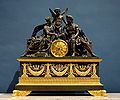
Pierre-Philippe Thomire
Encyclopedia


Ormolu
Ormolu is an 18th-century English term for applying finely ground, high-karat gold in a mercury amalgam to an object of bronze. The mercury is driven off in a kiln...
objects and furniture mounts of the First French Empire
First French Empire
The First French Empire , also known as the Greater French Empire or Napoleonic Empire, was the empire of Napoleon I of France...
. His fashionable neoclassical
Neoclassicism
Neoclassicism is the name given to Western movements in the decorative and visual arts, literature, theatre, music, and architecture that draw inspiration from the "classical" art and culture of Ancient Greece or Ancient Rome...
and Empire style furnishing bronzes (bronzes d'ameublement) established the highest standard in refined finish in the craft that the French called that of the fondeur-ciseleur, "founder-finisher". In his pre-Revolutionary training, Thomire appeared first as a ciseleur, in the division of duties that went into the production, for example, of a set of gilt-bronze wall-lights delivered for Marie-Antoinette's card-room, her Salon des Jeux at Compiègne
Château de Compiègne
The Castle of Compiègne is a French château, a royal residence built for Louis XV and restored by Napoleon. Compiègne was one of three seats of royal government, the others being Versailles and Fontainebleau...
: under the general supervision of Hauré, the wax and wooden model was carved by Martin, cast by Forestier, and chased by Thomire, as Pierre Verlet was able to show over fifty years ago.
He had received his training in the workshop of Pierre Gouthière
Pierre Gouthière
Pierre Gouthière , French metal worker, was born at Bar-sur-Aube and went to Paris at an early age as the pupil of Martin Cour....
, the outstanding Parisian ciseleur-doreur working in the Louis XVI style, before establishing his own shop in 1776. He gradually assumed the leading position of his former master. In 1784 a pair of Sèvres vases with Raphaelesque grotesques in violet on a white ground, made in 1782 were mounted with gilt-bronze goats as handles, which Pierre Verlet recognized in a memorandum delivered by Thomire, who was responsible for modelling in wax, casting, matte gilding and mounting on the porcelain. In 1783-84 he received his first notable commission, casting and finishing the gilt-bronze handles modelled by Boizot for a pair of Sèvres porcelain vases, today divided between the Musée du Louvre and Palazzo Pitti
Palazzo Pitti
The Palazzo Pitti , in English sometimes called the Pitti Palace, is a vast mainly Renaissance palace in Florence, Italy. It is situated on the south side of the River Arno, a short distance from the Ponte Vecchio...
.
Under the Empire, Thomire purchased the fashionable premises of the marchand-mercier
Marchand-mercier
A marchand-mercier is a French term for a type of entrepreneur working outside the guild system of craftsmen but carefully constrained by the regulations of a corporation under rules codified in 1613.. The reduplicative term literally means a merchant of merchandise, but in the 18th century took...
Martin-Éloi Lignereux, for whom he had provided furnishing bronzes in rue Taitbout, Paris. When he exhibited in the 1806 Exposition Publique des Produits de l'Industrie, the first time a bronzier was permitted among the exhibiters, he gained a gold medal. His most prestigious commission was the execution of the cradle for the King of Rome, which was designed by Pierre Paul Prud'hon
Pierre Paul Prud'hon
Pierre-Paul Prud'hon was a French Romantic painter and draughtsman best known for his allegorical paintings and portraits.-Life and work:...
and in which Thomire collaborated with the Imperial silversmith Odiot; in a second cradle, Thomire alone was responsible. At the height of his business, Niclausse estimated Thomire employed six or seven hundred workers. A great number of the bronzes by Thomire in the Imperial residences had been commissioned, but further bronzes were supplied as collateral for a loan that was extended to Thomire in 1807 and which he was unable to repay, which consequently passed into the Imperial collection in 1811.
Under the Restauration, Thomire Duterme and Cie. retained the highest clientele, Monsieur, the King's brother, the duc de Berry, and as furnishers to the Garde Meuble de la Couronne, though elaborate measures were taken to rededicate Napoleonic allegories in bronze and ormolu with suitably Bourbon ones. In one, Thomire cast and finished a martial allegory sculpted by Louis-Simon Boizot
Louis-Simon Boizot
Louis-Simon Boizot was a French sculptor whose models for biscuit figures for Sèvres porcelain are better-known than his large-scale sculptures.- Biography :...
, who had provided draped caryatid models for furniture mounts that were touched up by Thomire, applied to the upper corners of a secretary desk by Guillaume Beneman, delivered for the King's cabinet intérieure at Compiègne, 1787
In a notable commission for Count Nicolay Demidoff in 1819, Thomire produced finely-made figures of Fame with doubled trumpets to serve as handles for the massive malachite
Malachite
Malachite is a copper carbonate mineral, with the formula Cu2CO32. This green-colored mineral crystallizes in the monoclinic crystal system, and most often forms botryoidal, fibrous, or stalagmitic masses. Individual crystals are rare but do occur as slender to acicular prisms...
-veneered vase now at the Metropoolitan Museum. Thomire retired from his firm in 1823.
External Links
- Grand Ormolu / Surtout de table by Pierre-Philippe Thomire at the Wilanów Palace Museum

